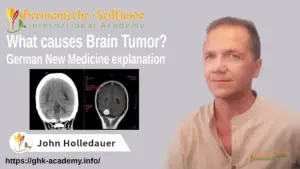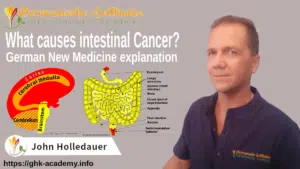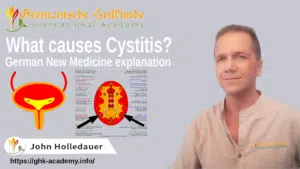
Before the therapy, God has placed the diagnosis, which in German New Medicine is fundamentally different from the procedure of conventional medicine. In contrast to conventional medicine, we in Germanic use the organ level, the patient’s psyche, and the brain level.
An important and exciting topic.
Diagnostics is an exciting topic, because we have three levels available to work with, the level of the psyche, the brain, and the organ, which always proceed synchronously.
Thus, of course, we can always draw conclusions from one level to the other two levels.
If, for example, we know the organ level with the symptom of a”growing knot in the breast,” then we naturally also know where in the brain the Hamer focus must be located, and we know the psyche of the woman.
In this patient’s brain, from the Brain relays in the cerebellum at the very left outside, crossed to the right breast, we must find a photographable, shooting-disc-shaped Hamer focus.
The patient must have compulsive thinking about an active mother/child, or partner/care conflict in the psyche.
If one asks the person about this unsolved conflict, this will probably be cause enough for spontaneous tears. Tears are an indication of an active conflict.
However, if one does not recognize a sharp-ringed or edematized Hamer focus in brain Ct, then one again knows the organ level and the psyche.
On the organ level, the cell division has stopped after conflict resolution, and now the microbes are active, which will decompose this node tuberculously.
Depending on the conflict load, one knows now how long this painful healing will last, just as long as the active phase has lasted.
Thus, we can look into the future, in the same way as we can predict the time of birth during pregnancy.
With the psyche, one must now be able to find a resolved worry or dispute conflict.
If we know both the conflict and the solution, what was conflictive at that time, and what was the solution for this, then we begin to understand Germanische Heilkunde.
The easiest way is to start the diagnosis from the organ level.
As we know, the organ level cannot lie. If there is a symptom, then there must be a special program running.
It is the same with the brain CT; the Hamer focus must be present photographable in the corresponding relays.
If the brain CT shows a Hamer Focus, then you know what’s going on at the organ level, and what’s going on at the psyche level.
Starting from the psyche alone is probably the most challenging thing. But even that works if you know what you are doing.
About two years ago, he had come across Germanische Heilkunde. As a trained nurse in a hospital, medicine finally became a logical system for him with Germanische Heilkund.
He finally found answers to his previously unanswered questions. So, this seminar participant was a real fan of Germanische Heilkunde.
He went on to tell me about a conversation he had with an about 70 years old man.
About 50 years ago, this now 70-year-old was at a carnival parade and observed a terrible accident.
A young boy fell off the trailer, and the tractor tires ran over the child’s rib cage, causing his guts to spill out of his mouth. A terrible accident 50 years ago.
What was particularly bad about it was that he knew the victim’s family very well. The driver of the tractor was the boy´s grandfather.
The nurse said to this 70-year-old that he should have vitiligo on his chest, the white spot disease.
The nurse came to this conclusion by empathizing with the psyche of the then 20-year-old to his organ level.
The nurse recognized the ugly component and the separation conflict: wanting to have the child separated from the tractor tires, thus locally related to the rib cage.
The 70-year-old widened his eyes and asked, “Who told you about my vitiligo?”
Now that’s what I call diagnostic.
The nurse thus also showed that he would be suitable as a therapist of Germanische Heilkunde. Not everyone can do this, to be able to put oneself in the other person’s shoes, because many people are without empathy.
Among them are those who are developmentally retarded due to territorial constellations. The developmentally retarded person with emotional maturity of a 10-year-old cannot possibly put himself into the psyche of a betrayed 40-year-old wife.
The therapist in Germanische Heilkunde should be an Alpha. The Alpha is not developmentally retarded. Only the wise can give wise advice, logical, right?
So, the nurse deduced from the psyche of the 70-year-old to his organ level, and landed a bull’s eye.
But if you think about it in more detail, what exactly did the nurse find?
Of course, the conflict is the cause of the vitiligo, which the affected person has also had since then.
But was the nurse also able to recognize whether this conflict was still active or already old news?
Yes, he could see that too, namely in the face of the other person by the tears in his eyes. The 70-year-old was visibly affected, and the organ level provided the proof.
So our nurse recognized the conflict content and assigned this from the diagnosis chart to the organ symptom. Hats off;
that’s the hardest part.
Easier is the approach via the organ level. If the patient has vitiligo, one only has to look for the associated conflict. When the affected person comes to talk about this active conflict, his voice, facial expressions, and the moisture in his eyes change.
With some empathy, one can thus pinpoint the conflict. To be able to play with these three levels requires, of course, a certain experience.
And, of course, in the diagnostics of Germanische Heilkunde, parameters from laboratory diagnostics are also included. So laboratory values there would be our organ level. And laboratory values are facts, period.
Because everything must have a reason, if the laboratory values are significantly out of the norm, then a corresponding special program must be running.
But beware: the evaluation of the laboratory values in conventional medicine is entirely different than in GHK.
For example, a high blood count of thrombocytes in conventional medicine means that you have leukemia, but in GHK, you are in the healing phase with the bone.
In conventional medicine, leukemia is like a death sentence for the patient; that makes him panic, and there is no way out but to fight!
In Germanisch Heilkunde the same lab value means something totally different, you were successfully solving your conflict, and now you are in the healing phase.
Congratulations, soon you will be healthy again.
Thus, no panic on the part of the patient, and thus no follow-up conflicts.
Fortunately, I could solve the conflict because otherwise, I would die of the anemia, or my bone would dissolve.
So, we are happy about these laboratory values, while conventional medicine falls into blind actionism, and the ignorant patient purposefully panics.
In conclusion: The diagnostics in the Germanische Heilkunde is overdetermined by its three levels and, therefore, very accurate.
We must find the triggering moment. Everything else around this biological conflict – the DHS – is only explanation.
You can learn this, too, because it is logical. Everyone can easily understand it.
Germanische Heilkunde is not only logical, but it is also biological.
Have fun with your continued study of Germanische Heilkunde.
Goodbye until the following video.






| Cookie | Duration | Description |
|---|---|---|
| cookielawinfo-checkbox-analytics | 11 months | This cookie is set by GDPR Cookie Consent plugin. The cookie is used to store the user consent for the cookies in the category "Analytics". |
| cookielawinfo-checkbox-functional | 11 months | The cookie is set by GDPR cookie consent to record the user consent for the cookies in the category "Functional". |
| cookielawinfo-checkbox-necessary | 11 months | This cookie is set by GDPR Cookie Consent plugin. The cookies is used to store the user consent for the cookies in the category "Necessary". |
| cookielawinfo-checkbox-others | 11 months | This cookie is set by GDPR Cookie Consent plugin. The cookie is used to store the user consent for the cookies in the category "Other. |
| cookielawinfo-checkbox-performance | 11 months | This cookie is set by GDPR Cookie Consent plugin. The cookie is used to store the user consent for the cookies in the category "Performance". |
| viewed_cookie_policy | 11 months | The cookie is set by the GDPR Cookie Consent plugin and is used to store whether or not user has consented to the use of cookies. It does not store any personal data. |
You’ll be informed by email when we post new articles and novelties. In every email there is a link to modify or cancel your subscription.